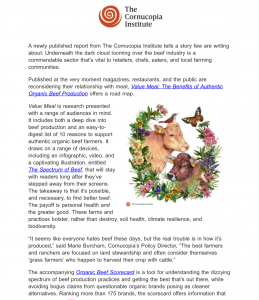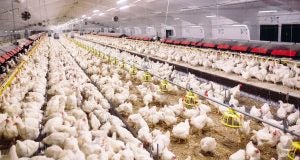I recently came across this ad from the Cornucopia Institute, which bills itself as a farm-research organization but also acts largely as an organic-industry-sponsored lobbying group that tries to sell its sponsored products. Cornucopia has, unfortunately, been known to spread misinformation about agriculture for years.

Whenever “reports” like this cross my desk, I can’t help but often roll my eyes. With catchy buzzwords like “dark cloud” and claiming that nonorganic farms “destroy soil health and biodiversity,” it ends up maddening. The U.S. has had the lowest beef GHG emissions intensity in the world for 25 years, and any livestock producer can do an excellent job regardless of size or label.
So what are the facts? There are so many options at the meat counter now-a-days, how do we choose what is best? If you want the truth, there is no “best” option. Not all meat is created equal, and that’s actually a really good thing for consumers. Many people have the beautiful and most preferred option of buying direct from a local farm. We can get to know them and who they really are, support that family and their specific practices. We don’t need “organic only” spin.
Families have been plagued with an over-load of opinions on what are the best products to purchase. However, those “opinions” are exactly that, opinions, most of which are rarely backed by peer-reviewed scientific, factual, or research-based information. Many opinions and articles are actually subliminal advertisements for a particular product. Marketing representatives have realized how much the average consumer will trust a regular blogger or social media influencer, regardless of their qualifications.

Here is the truth about the different types of poultry and livestock production methods:
Conventional: These animals are raised all across the country in a number of different ways. Each producer may have different goals or focus their operation to meet certain parameters. Most producers in this category wouldn’t “label” their product in any particular way, and the majority of meat found in the grocery store would fall under this classification. Conventional producers use new and old production methods to develop superior products; these may be highly advanced technologies or the most basic of skills. Livestock raised in this production style could have received antibiotics if they were sick (there is a withdraw period before the animals are processed), growth hormones (beef cattle only) to maximize resources, or other medications if needed.
Organic: Organic meat is difficult to define. Certified organic producers must follow guidelines from the U.S. Department of Agriculture (USDA) and be approved to use the Certified Organic USDA label. Certified organic producers are inspected to verify guidelines are followed. Some producers may not be certified organic but can still utilize the organic verbiage on their packaging, however they will not be able to use the National Organic Program seal. Livestock produced under organic conditions will have to be fed certified organic feed, they are not administered antibiotics or hormones, although they likely received vaccinations. You can learn more about the specifics of raising organic livestock in this USDA document.
No Added Hormones: This meat can be raised in a variety of production styles, but the animal was never administered additional hormones. It is illegal to use growth hormones in pork and poultry production in the United States, therefore every item containing pork or chicken (raw or cooked meat) is free of added hormones. Of course, every living thing has naturally occurring hormones: meat, fruit, and vegetables included. So nothing is really “hormone-free,” but products can be “added-hormone-free.” If you’d like to not eat added-hormones (although perfectly safe, we understand you have the choice!), then look for this label on beef and dairy products, since those livestock are the only ones legally allowed to have them.
No Antibiotics Ever: This label means the livestock animal that the meat came from was never administered antibiotics. It’s important to know that all animals who are given antibiotics, or any medication for that matter, must undergo a withdrawal period before they can be slaughtered. This ensures the drug has had time to metabolize (breakdown) in the body and will not be present in the meat. It’s against the law to sell meat containing antibiotics, so even if animals require antibiotics to ensure their health, the final meat product will be free of antibiotics — so it’s safe to eat! Many producers who raise livestock destined for “antibiotic free” labeling can still administer antibiotics to an animal in need, however this animal will have to be separated and raised in a different production line as the meat can no longer be marketed “no antibiotics ever.” There is a difference between antibiotic-free and no antibiotics ever.
There are so many ways to raise livestock. Poultry, pork, beef, and dairy producers across the country raise animals in different ways since differences in geography, climate, urbanization, tradition, religion, and state or local regulations can dictate how they can do things. Consumers can be confident that regardless what the label says, all livestock raised in the U.S. is safe and wholesome! Meat is continuously tested throughout production systems, each animal is inspected before it is slaughtered, and hundreds of thousands of samples are taken each year to verify food safety protocols are working!
The only “best” production style is the one that is best for your family. You may choose to purchase a particular product based on your individual values or opinions. As long as you are getting information from unbiased, factual sources, then you are doing what is best!
Michelle Miller, the Farm Babe, is a farmer, public speaker and writer who has worked for years with row crops, beef cattle, and sheep. She believes education is key in bridging the gap between farmers and consumers.



